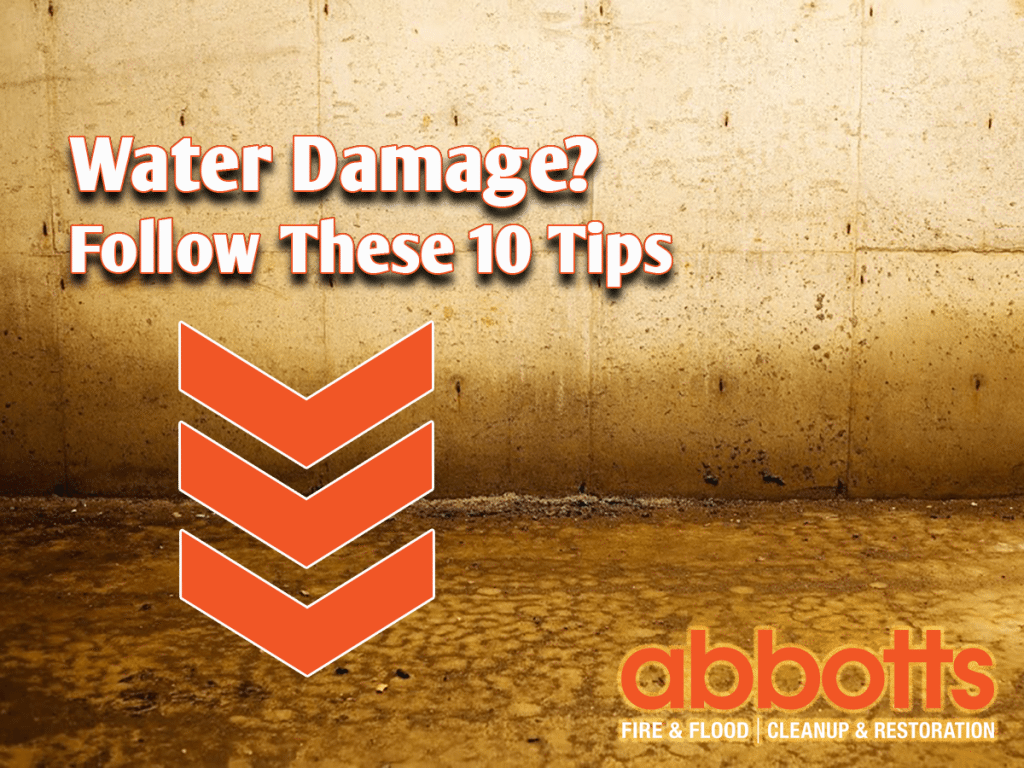
Water Damage? Follow These 10 Tips
Water damage from flooding or plumbing issues like frozen, ruptured pipes can present harrowing challenges. It’s hard to know what to do first when the water recedes. Act fast and follow these tips after the water recedes to minimize damage and make the process of restoring your property easier and faster.
Water Damage Tip #1 – Look for Safety Hazards
Before entering flooded or recently flooded structures, make sure you check for potential safety hazards. Ensure that all electrical power and gas is off in areas affected by water damage. Be aware that wild animals and venomous insects can be washed into structures by flood waters. Rubble and debris can be hidden by dirty, standing water. And flood waters can contain chemical and biological contaminants.
Water Damage Tip #2 – Look for Signs of Mold
Closely related to watching out for safety hazards (but worthy of its own tip) is understanding what conditions contribute to mold growth and watching for its signs. Mold can produce hazardous and even toxic spores that can trigger serious respiratory problems. Some molds produce toxins that can cause health problems even for healthy people.
Water Damage Tip #3 – Check Structural Integrity of Flooded Buildings
Remember that water weakens most construction, particularly if the water was present for an extended period. Check basements, foundations, load-bearing walls and columns for cracks and structural weakness (erosion, crumbling). Pay particular attention to basement walls, which can be significantly weakened if the basement was dried out while the ground around it was still waterlogged.
Water Damage Tip #4 – Wear Protective Clothing
Protect yourself with gloves, goggles and head protection, and consider respiratory protection. Remember that flood water is likely to contain chemical and biological contaminants that pose a variety of health risks. Ensure that you wash and disinfect cleanup equipment and yourself after working in water damaged areas.
Water Damage Tip #5 – Document Damage
After carefully assessing safety hazards and taking appropriate precautions, you’re ready to assess the damage and plan to dry and restore the property. As you assess the damage, make sure you take photos, which may be useful when working with your insurance company.
Water Damage #6 – Dry Structures Out As Soon As Possible
Newer structures, homes and businesses should be dried out as quickly as possible to minimize the growth of mold and reduce the risk of wooden and masonry structures rotting.
The first priority should be to get water out of the house. The length of time the water sits in your home will have a direct effect on the amount of damage. If you have a nearby open door, sweep the water out. If in a basement or a room without a door, you can use a shop vac for small sized damage areas or you may want to acquire a small pump for bigger jobs that can attach to your drill. You can rent a shopvac at many locations and find the inexpensive pumps at hardware stores. If your floor is carpeted, you’ll definitely want to use a shop vac to extract as much water out of the carpet as possible to avoid damage to your carpet. Remember, even if professional help is on the way, time is of the essence and anything you can do will help.
You may consider using large fans, heaters or air conditioners to dry the property as quickly as possible. However older or historic structures should be dried more slowly and naturally to avoid splitting and cracking in aging, fragile materials. If wood floors are warped, drying them may restore their original shape. However you may need to use weights or shoring to reduce or correct warping. Historic or aged wood flooring may crack if dried too quickly with forced, heated air.
Water Damage Tip #7 – Check the Attic
Ironically, the place to start drying a home is often in the attic. Insulation in the walls can wick moisture up into the attic. The insulation can hold moisture for a long time, and heat concentrated in the attic can spread it, causing mold growth and rot in wood and masonry. Check your attic for water damage and remove any water-soaked items and insulation.
Water Damage Tip #8 – Ventilate
Inspect water damaged rooms for wet plaster and sheetrock. You may have to remove and repair plaster, and almost certainly will have to replace sections of sheetrock. Open windows for ventilation and, if your electrical system is dry and safe, and you have attic fan, turn it on.
Water Damage Tip #9 – Clean and Disinfect
Once you have the structure ventilated and have removed waterlogged materials, sheetrock, carpeting, etc., clean the area thoroughly with a solution of bleach and water or other disinfectant. Wash walls, doors, stairs, rails, mantels, trim and other features to remove mud and residue.
Water Damage Tip #10 – Call Abbotts
If you have water damage to your home, these tips can help you get started safely cleaning and restoring your property. Remember, if you need help tackling hazards and cleanup challenges, you can call Abbott’s Fire and Flood Restoration at 303-975-4000 anytime, day or night, for experienced, professional help.
More info:

